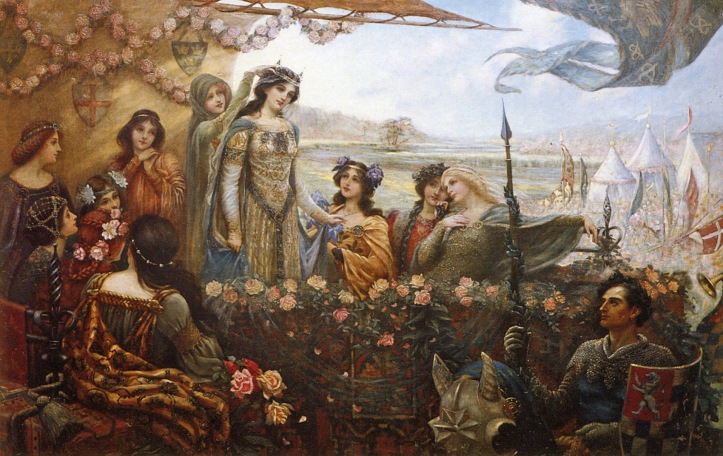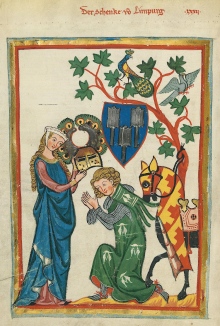
De Amore, more commonly known as The Art of Courtly Love, was written in the late twelfth century by Andreas Capellanus (Andreas the Chaplain) as a guide to the theory and practice of love. Capellanus was a friend and contemporary of Chretien de Troyes and though he was not really a literary figure himself, his manual offers an invaluable insight into life in the French court. Along with medieval manners, the rules of love were taught and probably practiced to a point.
The idea that love as we know it was invented in this period is frankly ridiculous. Even if you’re inclined to believe that love is a construct rather than a feeling (science would disagree), Capellanus and de Troyes did not invent what we would call romantic love. Ovid’s The Art of Love and The Cure for Love predate Capellanus’ text by some twelve hundred years and contain many of the same ideas: that women’s power over men is absolute, men must do anything necessary to please them (including neglecting basic necessities such as sleep and food), and that a little jealousy goes a long way.
Many of the ideas or “rules” still hold true today, but one of the starkest differences is the irrelevance of marriage. Ovid and Capellanus agree that marriage has nothing to do with love – it is not the object of falling in love, and it’s not an excuse to not fall in love with someone other than your spouse. The obstacle of a husband can even make love sweeter because it is forbidden.
Similar ideas also existed in 11th century Spain. In 1022, Ibn Hazm compared contemporary ideas about love to that of the Bedouins and ancients including Ovid and Plato. He agrees that people in love may experience jealousy and palpitations, but also subscribes to Plato’s idea of soulmates, that true love is a reunion of souls that have been separated since creation. He differentiates between love and passion: passion may be felt for any number of people, but true love can only be felt for one.

By the time Chretien de Troyes was writing at the end of the twelfth century, the ideal of chivalry had firmly taken hold among knights and courtiers as a code of social and moral conduct. In addition to piety, prowess, and generosity, it was common for knights to pay court to the wives of their masters or to other great ladies. This was accepted and even encouraged not as an attempt to make off with the woman, but to honor your lord by honoring his wife. Nothing was expected to come of it. Alternatively, some people preferred the idea of platonic love or “pure love,” which was a spiritual, non-physical devotion thought to improve the character of the lovers, because people in love are selfless and they constantly try to better themselves for the sake of their beloved (in theory).
So far, so PG. Were there people engaged in extramarital affairs? Did people ever marry for love? Of course. Just because love was separated philosophically from marriage at the time does not mean they did not sometimes coincide. We can no more generalize about love and marriage in the middle ages than we can about the same subjects today. What we can do, though, is read Capellanus’ rules and see what they tell us about the medieval vision of love:
The Rules of Love
I. Marriage is no real excuse for not loving.
II. He who is not jealous cannot love.
III. No one can be bound by a double love.
IV. It is well known that love is always increasing or decreasing.
V. That which a lover takes against the will of his beloved has no relish.
VI. Boys do not love until they reach the age of maturity.
VII. When one lover dies, a widowhood of two years is required of the survivor.
VIII. No one should be deprived of love without the very best of reasons.
IX. No one can love unless he is impelled by the persuasion of love.
X. Love is always a stranger in the home of avarice.
XI. It is not proper to love any woman whom one would be ashamed to seek to marry.
XII. A true lover does not desire to embrace in love anyone except his beloved.
XIII. When made public love rarely endures.
XIV. The easy attainment of love makes it of little value; difficulty of attainment makes it prized.
XV. Every lover regularly turns pale in the presence of his beloved.
XVI. When a lover suddenly catches sight of his beloved his heart palpitates.
XVII. A new love puts to flight an old one.
XVIII. Good character alone makes any man worthy of love.
XIX. If love diminishes, it quickly fails and rarely revives.
XX. A man in love is always apprehensive.
XXI. Real jealousy always increases the feeling of love.
XXII. Jealousy, and therefore love, are increased when one suspects his beloved.
XXIII. He whom the thought of love vexes eats and sleeps very little.
XXIV. Every act of a lover ends in the thought of his beloved.
XXV. A true lover considers nothing good except what he thinks will please his beloved.
XXVI. Love can deny nothing to love.
XXVII. A lover can never have enough of the solaces of his beloved.
XXVIII. A slight presumption causes a lover to suspect his beloved.
XXIX. A man who is vexed by too much passion usually does not love.
XXX. A true lover is constantly and without intermission possessed by the thought of his beloved.
XXXI. Nothing forbids one woman being loved by two men or one man by two women.
Having read this, indulge me for a moment and apply it to the medieval literature you know. I’ll make it easy for you. Probably the most enduring love story of the middle ages is that of Lancelot and Guinevere. It’s still being re-imagined in countless books, films, and TV, but from a modern perspective, it’s always problematic. Guinevere is read by most as thoroughly unsympathetic, cheating on “poor Arthur” with his dreamy right hand man. She is jealous, unfaithful to Arthur, and incredibly demanding (remember that sword bridge he crossed for her in The Knight of the Cart?), and plenty of people have delighted in writing Lancelot a nice, sane girlfriend to replace the crazy Queen who is obsessed with him.
Okay, I’m exaggerating, but only a little. Read through Capellanus’ rules and think about Lancelot and Guinevere again. It’s only a bad relationship through modern eyes. As a romance in the twelfth century, it was not about the infidelity, but a story about the perfect love. Guinevere is unfaithful to her husband, jealous, and demanding, yes, but this is what proves her love for Lancelot. Lancelot does everything she asks and more because he is completely devoted to her. Her marriage is irrelevant because she doesn’t love Arthur; she is faithful in her heart to Lancelot, and that’s all that matters. Everything they do, good or bad, is for love of each other, and that’s how you know it’s real. This story was not a precautionary tale for wives. In every instance Guinevere is almost punished, Lancelot betrays the King to save her. It’s a romance, and at the time, it may have been the ultimate one.
Chretien de Troyes’ romances and Andreas Capellanus’ manual were written at the same time for the same audience and shared the same ideas. The latter can be used as a key to better understanding the former, and both offer an invaluable insight into the theory and practice of love in twelfth century France.
Jessica Cale
A note on the sources: I used the 1941 translation of The Art of Courtly Love by John Jay Parry. His preface and introduction include extensive notes on the historical context of this text, notably references to Ovid, Plato, and Ibn Hazm. There are other translations of this available, but his information is what I used for the beginning of this post. Comparisons between this text and the romances of Chretien de Troyes are my own and based in part on a thesis I wrote on the subject for Swansea University in 2007.
Further reading:
The Art of Courtly Love. Andreas Capellanus.
The Knight of the Cart. Chretien de Troyes.
Le Morte d’Arthur. Thomas Malory.
Lancelot du Lac (The Vulgate Cycle).

Reblogged this on spiritofnlm.
LikeLike
[…] Source: The Art of Courtly Love: Romance in 12th Century France […]
LikeLike